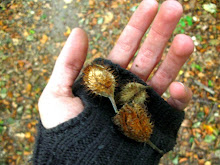Sunday, April 25, 2010
Sunday, January 3, 2010
spam1
massacre took place, and a stone was erected, which (possibly) still
remains. The lady's family had a grant from Sir Ferdinando Gorges of the
territory thereabout, and her brother had likewise come over and settled
in the vicinity. I believe very little of this story. Long afterwards,
at about the commencement of the Revolution, a descendant of Fowler came
from England, and applied to the Judge of Probate to search the records
for a will, supposed to have been made by Lady Ursula in favor of her
lover as soon as she heard of his existence. In the mean time the estate
had been sold to Colonel Whipple. No will could be found. (Lady Ursula
was old Mrs. Cutts, widow of President Cutts.) The mode of living of
Lady Ursula's brother in Kittery. A drawbridge to the house, which was
raised every evening, and lowered in the morning, for the laborers and
the family to pass out. They kept thirty cows, a hundred sheep, and
several horses. The house spacious,--one room large enough to contain
forty or fifty guests. Two silver branches for candles,--the walls
ornamented with paintings and needlework. The floors were daily rubbed
with wax, and shone like a mahogany-table. A domestic chaplain, who said
prayers every morning and evening in a small apartment called the
chapel. Also a steward and butler. The family attended the Episcopal
Church at Christmas, Easter, and Good Friday, and gave a grand
entertainment once a year. Madam Cutts, at the last of these
entertainments, wore a black damask gown, and cuffs with double lace
ruffles, velvet shoes, blue silk stockings, white and silver stomacher.
The daughter and granddaughters in rich brocades and yellow satin. Old
Major Cutts in brown velvet, laced with gold, and a large wig. The
parson in his silk cassock, and his helpmate in brown damask. Old
General Atkinson in scarlet velvet, and his wife and daughters in white
damask. The Governor in black velvet, and his lady in crimson tabby
trimmed with silver. The ladies wore bell-hoops, high-heeled shoes,
paste buckles, silk stockings, and enormously high head-dresses, with
lappets of Brussels lace hanging thence to the waist. Among the
eatables, a silver tub of the capacity of four gallons, holding a
pyramid of pancakes powdered with white sugar. The date assigned to all
this about 1690. * * * * * What is the price of a day's labor in
Lapland, where the sun never sets for six months? * * * * * Miss
Asphyxia Davis! * * * *
remains. The lady's family had a grant from Sir Ferdinando Gorges of the
territory thereabout, and her brother had likewise come over and settled
in the vicinity. I believe very little of this story. Long afterwards,
at about the commencement of the Revolution, a descendant of Fowler came
from England, and applied to the Judge of Probate to search the records
for a will, supposed to have been made by Lady Ursula in favor of her
lover as soon as she heard of his existence. In the mean time the estate
had been sold to Colonel Whipple. No will could be found. (Lady Ursula
was old Mrs. Cutts, widow of President Cutts.) The mode of living of
Lady Ursula's brother in Kittery. A drawbridge to the house, which was
raised every evening, and lowered in the morning, for the laborers and
the family to pass out. They kept thirty cows, a hundred sheep, and
several horses. The house spacious,--one room large enough to contain
forty or fifty guests. Two silver branches for candles,--the walls
ornamented with paintings and needlework. The floors were daily rubbed
with wax, and shone like a mahogany-table. A domestic chaplain, who said
prayers every morning and evening in a small apartment called the
chapel. Also a steward and butler. The family attended the Episcopal
Church at Christmas, Easter, and Good Friday, and gave a grand
entertainment once a year. Madam Cutts, at the last of these
entertainments, wore a black damask gown, and cuffs with double lace
ruffles, velvet shoes, blue silk stockings, white and silver stomacher.
The daughter and granddaughters in rich brocades and yellow satin. Old
Major Cutts in brown velvet, laced with gold, and a large wig. The
parson in his silk cassock, and his helpmate in brown damask. Old
General Atkinson in scarlet velvet, and his wife and daughters in white
damask. The Governor in black velvet, and his lady in crimson tabby
trimmed with silver. The ladies wore bell-hoops, high-heeled shoes,
paste buckles, silk stockings, and enormously high head-dresses, with
lappets of Brussels lace hanging thence to the waist. Among the
eatables, a silver tub of the capacity of four gallons, holding a
pyramid of pancakes powdered with white sugar. The date assigned to all
this about 1690. * * * * * What is the price of a day's labor in
Lapland, where the sun never sets for six months? * * * * * Miss
Asphyxia Davis! * * * *
Thursday, December 31, 2009
Wednesday, November 25, 2009
Saturday, November 14, 2009
Sunday, October 18, 2009
untitled

after turning off hissing & spitting ~ in Its image to behold the singular stretching into earth is but a march of questions to the throne of human skulls ~ you cannot ask answer or whisper even ~ but boars by Its side abide and abide by the one law alone ~ us Beings alone imagine neither life on the ground or in the air ? no recollection of deep electricity runs (the beasts we fall prey to) and so The Great Ruler and all Its likes will never even look upon us ~ we who dwell in buildings are lost
Subscribe to:
Comments (Atom)




